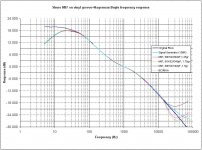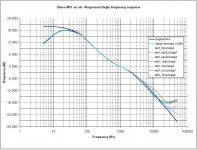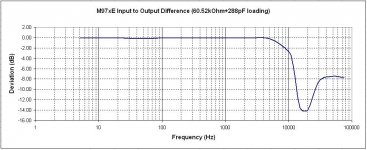Or one may have a mismatch between the cartridge and phono stage. For example, if an Ortofon LM series cartidge has say half the capacitance it should have, 200 instead of 400 pF, this will cause a hump, a rise of 3-4 dB in the 10-20 kHz range, which will accentuate noise and may subjectively sound a little shrill.
When I was working on Shure M97 (1.55kOhm, 700mH ) I found that capacitive loading was affecting the frequency response but only above ~15kHz. Resistive loading was effective from 1kHz .
Test set-up: Signal generator (100 Ohm, 4.9mVrms out) in series with M97, feeding a Hagerman Bugle 1 RIAA preamplifier.
Notice the damping of the response above~15kHz when cartridge tip is on the vinyl groove (compared to the on air case) and also the change of this damping with tracking weight.
George
Attachments
The irony GOBS of feedback, op-amp + CFP.
Scott
I thought that the Voltage gain of each section of this amplifier is x26.7
After your comment I looked at the schematic again and I am not sure of a correct answer.
The IC is in the control path of this very interesting Vin reduction (overload protection) circuit, no?
George
And playback hardware. That 16 bits is enough can't be emphasised enough - 30 years ago I managed to fluke superb sound from digital, by just happening to do enough to make it slip into a state of sufficient 'correctness' - it was "Wow, this is amazing!!". And this was at the time when digital in the showrooms always sounded really crappy, sales people and the hifi magazines were constantly pouring poo from a great height over everything digital - internally, I was just shaking my head, wondering how long it was going to take to sort this "mess" - the "anti-digital push" ...Trust Demian to say it gently, unlike myself, who said it bluntly. 16 bit is all we REALLY need, we have it, it's now a fairly mature technology.
All we need now is the software worthy of it, let alone higher bit processing.
There's your problem - digital playback can so, so easily inject a very subtle layer of distortion that badly degrades the listening experience - so far, it seems almost impossible to measure, the objectivists can never find anything. Yet, it is a distortion - totally eliminate it, and you fall off your chair at the quality of the sound. Then, you can go and listen to a top notch vinyl system, with the owner carrying on about the inherent "betterness" of analogue - but, inwardly, you quietly smile ...I find all the ESS DAC implementations I have heard somehow lacking. They measure nearly perfect but have some quality that interferes with the music. They have a lot of fans however.
Hi,
Here's what I use:
- All records cleaned with Keith Monks machine using a homebrew fluid of demineralized water, isopropanol, wetting agent.
- All records treated with LAST preservation product.
- All records iner sleeves replaced with Nagaoka anti-static sleeves.
- Stylast on stylus tip.
- TT Nothingham Analogue (a 60kg machine), can't recall the model's name.
- Air Tangent // tracking arm.
- J.Allaerts MC One Boron cartridge with Fritz Gyger's top of the line tip.
- My own MC headamp using valves. (as publicized on this forum).
- My own design MM phono preamp which also uses valves (ditto as above).
- Croft OTL 100W mono blocks.
- SD Acoustics SD1 speakers (92dB 1W/m).
Just no noise, no ticks or pops ever.
Note that some of my records used to tick and pop and you could hear the stylus track the groove. Some records used to belong to my parents and are over 40 years old, BTW.
Ever since I use this maintenance routine and the fantastic cartridge it's all gone.
Moreover, records just don't seem to wear any longer.
Ciao,
LAST is great stuff..... prevents wear of the stylus and LP AND lowers distortion. I used to use all their products. It is the real deal. I knew both partners for the LAST product. One of them lived 3 houses from me. Both partners were chemists at LLNL. This stuff is not marketing BS. I still have some, even though I dont have an LP system any more..... the LP system is just WAY to much messing around for me and it doesnt sound as good as the best digital possible today, IMO.
But the recording side of things is still sick on CD, also. Out of 10,000 blues tunes in my collection, there are only a hand full or two that are well recorded. But I like the music anyway.... not their recorded sound so much. We have the capacity to do a lot better recordings.
THx-RNMarsh
Last edited:
Sounds like you have a "sick" system, Richard ...But the recording side of things is still sick... even for CD's. Out of 10,000 blues tunes, there are only a hand full that are well recorded.
THx-RNMarsh
Got Bass?
 It is the recording that i am referring to - not the playback system. I have heard these tunes over decades -- first with the LP and later the CD of the same recording and on many iterations of my system. They sound better than ever but still sick. Classical recordings get the most expert recordists, it seems. They usually sound better on the whole as far as a recording is concerned. A lot more than a handful have been done very well. But then, I dont listen that often to classical. Just saying.... . I hope things get better.... and get rid of all that compression, pls.
It is the recording that i am referring to - not the playback system. I have heard these tunes over decades -- first with the LP and later the CD of the same recording and on many iterations of my system. They sound better than ever but still sick. Classical recordings get the most expert recordists, it seems. They usually sound better on the whole as far as a recording is concerned. A lot more than a handful have been done very well. But then, I dont listen that often to classical. Just saying.... . I hope things get better.... and get rid of all that compression, pls.
Some video music recordings are pretty good though. Esp the ones done in a TV studio in Germany ---- top equipment. Such as, Joe Louis Walker in concert. In-Akustic Gmbh & Co. KG. Recorded at Ohne Filter TV-Studio in Baden-Baden (INAK 6521-1 DVD). esp "Riding High" and "Hot Tamale Baby". Good stuff. Well done.
Another recording that was made distorted on purpose to sound like the 50's gear of that era; they used the oldest gear they could find in pawn shops etc. Including old mics. But I like it a lot because it is musically fresh (North Mississippi Allstars). Just saying..... we can do better on the whole with most recordings.
yes. Play at real levels.... for those who dont know --- which is 10 on the volume dial/knob. Or at least until the bass vibrates your guts, shakes the furniture and causes things to vibrate off the shelves in the adjacent room. You know ... the kind of bass that blows out candles and will press your pants if you stand close enough.
Or at least until the bass vibrates your guts, shakes the furniture and causes things to vibrate off the shelves in the adjacent room. You know ... the kind of bass that blows out candles and will press your pants if you stand close enough.
THx-Richard
Some video music recordings are pretty good though. Esp the ones done in a TV studio in Germany ---- top equipment. Such as, Joe Louis Walker in concert. In-Akustic Gmbh & Co. KG. Recorded at Ohne Filter TV-Studio in Baden-Baden (INAK 6521-1 DVD). esp "Riding High" and "Hot Tamale Baby". Good stuff. Well done.
Another recording that was made distorted on purpose to sound like the 50's gear of that era; they used the oldest gear they could find in pawn shops etc. Including old mics. But I like it a lot because it is musically fresh (North Mississippi Allstars). Just saying..... we can do better on the whole with most recordings.
yes. Play at real levels.... for those who dont know --- which is 10 on the volume dial/knob.
THx-Richard
Last edited:
Dynamic compression can be recovered to some degree at the moment, this chap is giving it a go, http://www.diyaudio.com/forums/pc-b...erly-compressed-recordings-5.html#post4044251 - the technique is very similar to my own. And down the track smart software will be able to unravel even very complex mixes of sounds, each compressed to various degrees; and uncompress as necessary - that will sort itself out in time.
The non-linear distortion is not a problem if the playback is good enough - I've got a real roughie of a Blues CD: no-name label, compilation of some oldies but goldies, most extremely "dirty". This comes to life when the system is up to it, wind it up to full volume - the man, and his guitar are in the room ...
The non-linear distortion is not a problem if the playback is good enough - I've got a real roughie of a Blues CD: no-name label, compilation of some oldies but goldies, most extremely "dirty". This comes to life when the system is up to it, wind it up to full volume - the man, and his guitar are in the room ...
The non-linear distortion is not a problem if the playback is good enough - I've got a real roughie of a Blues CD: no-name label, compilation of some oldies but goldies, most extremely "dirty". This comes to life when the system is up to it, wind it up to full volume - the man, and his guitar are in the room ...
Yes I know this is a hopeless and useless discussion, hundreds of similar posts. "Good enough" playback never defined, or described as PC speakers + chipamp (realistic volume?
A point about knowing where I'm at with the sound - say, I put on some grubby old Blues recording, nominally pretty dicky sound; I listen closely to the voice - does it sound like a caricature, an obvious "fake", something pretending to be a man singing but not quite making it? When I can't pick it from a "real" voice, then the rest of the sound should be up to scratch ...
Wrong. I have already mentioned "invisible speakers", many times - this is as clear a test as any, and easily "scientifically" tested: put on a blindfold, and see if you can easily point to the speaker drivers or not. When you can't, then the playback is certainly "good enough" ...Yes I know this is a hopeless and useless discussion, hundreds of similar posts. "Good enough" playback never defined, or described as PC speakers + chipamp (realistic volume?). "Good enough" playback that converts bad and dirty recordings to good ones is based on added distortion that masks original flaws.
Edit: of interest, the Yamaha keyboard gets mighty close in raw form, when I make sure interference is minimal - would only require a touch more fiddling to get it over the line.
Last edited:
Well, dvv, I posted before I read your last message. It is then still possible that what Demian and I are still finding, might be the analog portion of the circuit. It gives me 'hope' because I can fix that, but not the 'digital' part.
John, it was the division of labor that got man off the trees and down to the ground. So, leave the digitalia to those who specialize in it, I'm sure there are some awfully good people around.
As we all know, the trouble with CD playback is that they seem to think everything can be solved with op amps. And it can, but at what price? You pay either at the gate, or at the portal. Having great digital circuitry followed by lesser analog circuitry is a waste of time.
THAT'S where you and Demian kick in. You know alanog better than those digital guys. You c an finish their work with flying colours.
What you need are two same CDs, one to be used as is, and the other with its analog part removed and your circuitry installed. Then demo as a classic A/B test. And it would be best if you used a relatively cheap model, I suspect it will show up a large difference.
After that, you talk to people you percieve as possible customers. Today, in this cuthroat competition, everybody is looking for an edge, and you may be just that edge they need.
When I was working on Shure M97 (1.55kOhm, 700mH ) I found that capacitive loading was affecting the frequency response but only above ~15kHz. Resistive loading was effective from 1kHz .
Test set-up: Signal generator (100 Ohm, 4.9mVrms out) in series with M97, feeding a Hagerman Bugle 1 RIAA preamplifier.
Notice the damping of the response above~15kHz when cartridge tip is on the vinyl groove (compared to the on air case) and also the change of this damping with tracking weight.
It is to be expected that frequencies where MM cartridge loading optimization show up, are a function of the resonance frequency of the particular cartridge.
George
Very possible George, I mentioned the 10-20 kHz range more as a precaution, I have no idea how other cartridges might react.
I would discuss with you power amps, but when it comes to phono playback, I bow to your knowledge and experience and gladly take the back seat. As a song says:
"... You got to know when to hold 'em,
You got to know when to fold 'em ..."
And playback hardware. That 16 bits is enough can't be emphasised enough - 30 years ago I managed to fluke superb sound from digital, by just happening to do enough to make it slip into a state of sufficient 'correctness' - it was "Wow, this is amazing!!". And this was at the time when digital in the showrooms always sounded really crappy, sales people and the hifi magazines were constantly pouring poo from a great height over everything digital - internally, I was just shaking my head, wondering how long it was going to take to sort this "mess" - the "anti-digital push" ...
That's beyond dispute, Frank, EVERYTHIBG needs good execution to work as well as it can.
Yes I know this is a hopeless and useless discussion, hundreds of similar posts. "Good enough" playback never defined, or described as PC speakers + chipamp (realistic volume?). "Good enough" playback that converts bad and dirty recordings to good ones is based on added distortion that masks original flaws.
Pavel, I think "good enough" is, to a large extent, a personal thing.
ANYTHING we speak of, be it preamps, amps, tuners, CD players, TT or loudspeakers, is subject to personal perception. One man's meat is another man's poison, and I think this is true nowhere else as much as in audio. Audio has always been an ego trip for far too many people.
- Status
- Not open for further replies.
- Home
- Member Areas
- The Lounge
- Sound Quality Vs. Measurements


